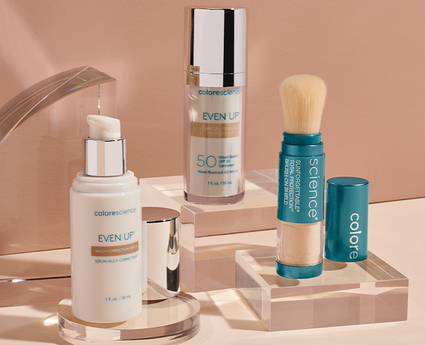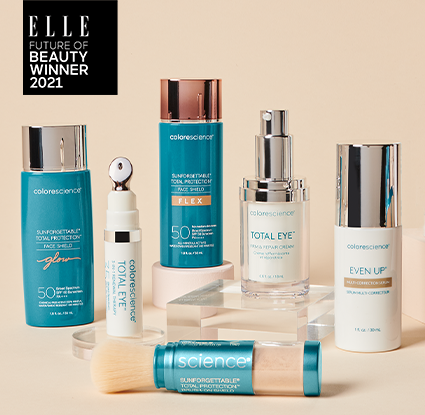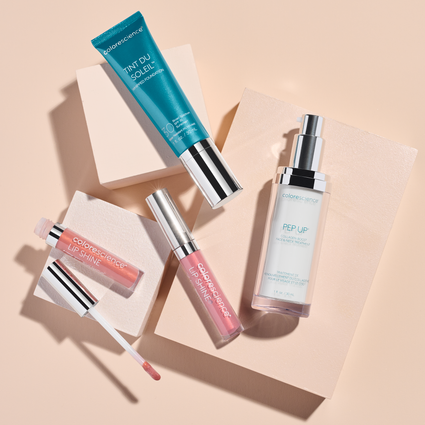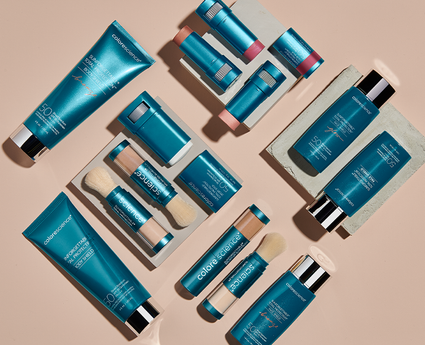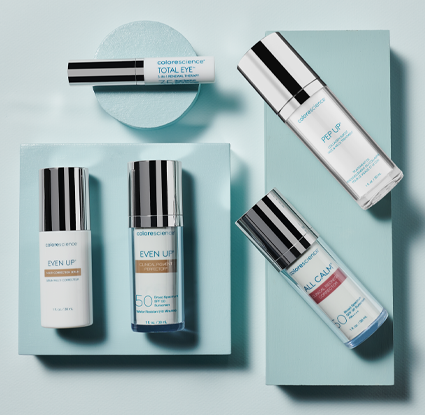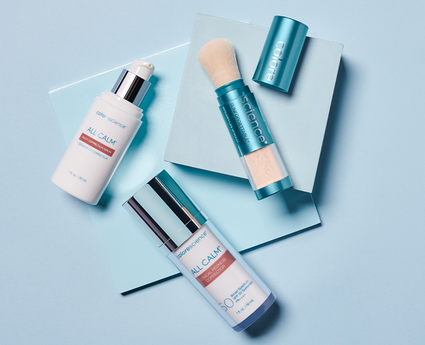How to Treat Sun Damaged Skin
Now that summer is coming to an end and our sun-soaked adventures are fading away, you might be shocked to notice some sun damage left behind in its place: fine lines that weren’t there at the beginning of the season; dark sunspots beginning to spackle your forehead; a red, blotchy complexion that just won’t quit.
If you see any of these signs, don’t panic just yet. Make sure you step up your SPF game and start learning the best treatments for sun damaged skin. Use the links below to learn more about how to heal your skin from the sun and restore its vitality back to a radiant glow.
- Can You Reverse Sun Damage?
- How to Determine if You Have Sun Damage
- Best Way to Remove Sun Damage from Your Face
Can You Reverse Sun Damage?
You can’t go back in time, but you can reverse some of the sun damage you’ve accumulated over the years. It’s important to note that sun damage is cumulative, below the surface, and potentially lethal. Skincancer.org recently published informative facts about the danger of sun exposure and the corresponding threat of skin cancer—which is the most common cancer in the United States and worldwide.

According to their research, only about 23% of lifetime exposure occurs by age 18. The majority of sun exposure occurs between ages 19 and 40; after this time, the signs of hidden damage start to present themselves above the surface, causing many to wonder how to look younger and find the best treatment for sun damaged skin on the face.
The best treatment for sun damaged skin will depend on the type of damage you’re trying to reverse. Let’s first discuss the different ways that harmful UV rays can present themselves and how to tell if they’ve injured your cell tissue. Once we know the problem at hand, then we can suggest the best way to remove sun damage from your face.
How to Determine if You Have Sun Damage
The term sun damage is often used interchangeably with “photoaging”, or aging that’s caused by exposure to UVA and UVB light. This is different from “chronological” aging—such as sagging cheeks induced by gravity, a lack of skin elasticity, and the loss of voluminous fat from the lips—which occurs naturally over time.
By contrast, 90% of aging is caused by the sun which, unlike natural aging, can be controlled and minimized. Some signs of photoaging are the same as those caused by nature’s clock, namely fine lines and wrinkles. That’s because sun damage occurs slowly and gradually, compounding on itself with every exposure.

In some cases, extended sun exposure results in immediate, painful sunburns that cause the skin to turn red, blotchy, hot to the touch, and in extreme cases, may lead to the blistering and peeling of dead cell tissue. Other signs that indicate you have sun damaged skin include:
- Premature wrinkles and fine lines
- Sunspots, liver spots, and freckles
- Broken capillaries, redness, and rosacea
- Uneven skin tone and melasma
- Actinic keratosis (AK)
We’ll go over these in more detail below, including the best treatment for sun damaged skin depending on which type you have.
Best Way to Remove Sun Damage from Your Face
There are many products and treatments for sun damaged skin on the face, some of which are stronger than others and more or less effective. Although you’ll never be able to fully restore tissue vitality nor entirely erase the signs of damage, you can reduce their appearance to reveal a more youthful, radiant glow.
Treatments for Wrinkles
Let’s face it, wrinkles are an inevitable (albeit unwelcome) fact of life. As we get older and mature into our mid 20’s, collagen production begins to slow down, the skin becomes less elastic, and fine lines begin to settle in. There are a number of anti-aging skincare regimens you can follow to slow this process down, but one of the best treatments for wrinkles caused by the sun: wear SPF every single day.
UVA rays penetrate deep into the skin’s dermal layer where they cause the breakdown of collagen and elastin fibers—two proteins in skin cell tissue essential for maintaining a smooth, seamless complexion. The application of physical sunscreen should be a non-negotiable part of your daily beauty routine, no matter the weather and regardless of how much time you’ll be exposed to the sun.
Remember: Most UV rays can penetrate clouds, even when you think the sun is hiding, and can damage your skin in as little as 15 minutes without protection.
Another way to combat wrinkles is by taking advantage of the Colorescience HydraFacial partnership experience, an in-office skin renewal treatment brought to you by Perk™, a patented roller-flex technology. Perk gently exfoliates dead skin cells while Colorescience’s Total Eye ™ serum is used to replenish the delicate skin around the eyes and restore it to a youthful glow.

If you’ve already noticed fine lines and crow’s feet beginning to form, here are the best treatments for sun damage that can prevent those wrinkles from turning into deeply etched grooves.
- Collagen boosts
Just because collagen and elastin fibers break down due to harsh UV damage, it doesn’t mean that you’re forced to say goodbye to your skincare BFFs once and for all. There are different types of nutritional supplements that can increase your collagen levels, but we recommend applying our Pep Up® Collagen Renewal Face & Neck Treatment, directly to your face and neck.
By applying a powerful blend of ingredients and peptides, you can stimulate your skin’s own collagen production. This treatment for sun damage on the face will repair and defend against wrinkles, enhancing skin texture and rejuvenating your complexion for a healthy appearance.

- Eye treatments
If you’re targeting fine lines around your eyes, our three-in-one Total Eye® Renewal Therapy is the best treatment for sun damage. The cooling applicator softens fine lines and wrinkles while brightening dark circles for an instantly refreshed, rested appearance. As an added bonus, it contains SPF 35 to defend against future sun damage.
- Skincare products
You’ll see cosmetic aisles lined with products offering treatment for sun damaged skin. Some of the best ingredients for diminishing wrinkles include:
Always choose cosmetic products sensitive to your unique skin type. If these over-the-counter (OTC) products aren’t doing the trick, a professional chemical peel is usually the best procedure for sun damaged skin, but talk to your dermatologist about the best options for you.
Treatments for Sunspots and Uneven Skin Tone
Sunspots (or “liver spots”) and an uneven skin tone (also known as “hyperpigmentation”) are other types of sun-induced skin damage that are all about melanin—the pigment responsible for the color of our skin. Melanin is our body’s natural defense against UV rays, which explains why you get tan after spending an unprotected day in the sun. It’s made by little cells called melanocytes, which are kicked into overdrive in the increased presence of UV light.
Hyperpigmentation occurs when melanin is overproduced, resulting in dark brown or grayish deposits on the skin that range in size and shape. The treatments for hyperpigmentation on the face are a little different than those to fight wrinkles.
- Clinical Pigment Perfector
Colorescience offers Even Up® Clinical Pigment Perfector®, which is tested and proven to immediately blur stubborn brown spots and improve skin discoloration. Our highly-effective, patented formula combines a mixture of vitamins, extremozymes, bioactive complexes, and botanical extracts to brighten the appearance of skin for a balanced complexion. In addition, it protects against future damage to the sun with its integrated SPF 50.
You can also invest in the Even Up® Corrective Kit, which delivers a convenient skin care routine created to help reduce the appearance of hyperpigmentation.
- Laser Treatments
Another option to treat hyperpigmentation is to get a professional laser treatment, which can help reduce unwanted skin discoloration. It may take more than a few treatments to see a difference. If you need treatment for sun damaged skin on the face that’s red and blotchy, versus brown and spotted, then you should try alternative color-correcting strategies that are designed to target inflammation.
In some cases, UV rays can trigger your blood vessels to expand and become increasingly red, especially if you struggle with rosacea. Light therapy is usually the best procedure for reducing redness. A dermatologist can recommend the right treatment for your particular skin concerns.
- Clinical Redness Corrector
Colorescience All Calm™ Clinical Redness Corrector is formulated with subtle green undertones to neutralize redness. The treatment is made with BioSolace ™, a proprietary blend of ingredients that excels in immediately relieving the appearance of redness. This product also acts as an effective shield against UVA/UVB rays to keep your skin health long into the future with integrated SPF 50.
Treatment for Melasma
Melasma is a skin pigmentation condition typically seen on the jawline, cheekbones, and central part of the face. It’s usually characterized by discolored patches of brown, tan, and blue-gray spots that also occur when melanin is overproduced.
Melasma is caused by genetics as well as hormonal fluctuations, but it almost always worsens in the summer when sun exposure is intensified. Although these spots are not harmful, as opposed to cancerous melanoma, some find them unsightly and seek treatment to improve their appearance as well as diminish the spots characteristic of this skin issue.
- Palette Corrector
You can use the Mineral Corrector Palette from Colorescience to camouflage and conceal melasma spots if you want to diminish their appearance. Five neutral shades instantly correct the look of imperfections and in turn, restore confidence.
- Microdermabrasion
Regular microdermabrasion sessions performed by a certified professional can help permanently remove the appearance of melasma. This is a minimally invasive procedure that removes the thick, outer layer of skin to improve cell turnover, thereby shedding the hyperpigmented cells.
Treatments for Actinic Keratosis (AK)

Unfortunately, one in five Americans will develop skin cancer by age 70—but if you detect an AK early on, you have an opportunity to treat the lesion before it develops into squamous cell carcinoma (SCC). An AK is a rough, scaly patch of skin that develops from years and years of sun exposure. They typically affect people over 40 and may appear like hard, wart-like surfaces typically found on the face, lips, ears, hands, forearms, and necks.
It’s difficult to determine a noncancerous AK from a cancerous one, so it’s always best to receive a doctor’s medical diagnosis and treatment suggestions, which generally involve freezing and tissue scraping.
Takeaway
Remember, prevention is always key when it comes to protecting the skin’s vitality, so be sure to shield your complexion with daily SPF. Colorescience makes sun protection effortless and prioritizes your skin’s health above all else—shop our line of PABA free sunscreen to find the formula that works best for your unique needs.
To keep your skin healthy and glowing, experts recommend visiting a dermatologist at least once a year. Find a Colorescience skin health professional by visiting our locator page so you can enjoy a beautiful, flawless complexion.

